Revolutionary methods of heating your home! Geothermal heating: what is it
You are viewing the section Geothermal, located in the large section Types.
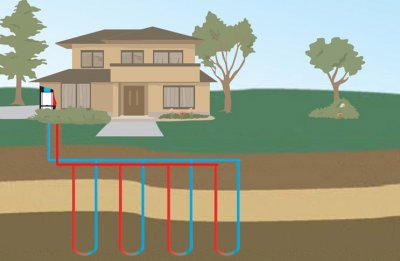
Geothermal is a method of heating rooms. due to energy obtained from the bowels of the earth.
In the 70s of the XX century, an oil crisis broke out. Industrialists began to look for a way to replace fuel with an alternative source.
This is how the first geothermal heating appeared.
Today, this type of heat production is widespread. in North America and Western Europe.
Content
- Geothermal heating from under the earth's crust: what is it, the principle of operation
- Internal and external views of earth contours
- Air to water heat pump: diagram
- Horizontal installation of a system operating due to the heat of the earth
- Vertical installation
- Installation of geothermal heating for a private country house
- Useful video
- Payback, amount of energy produced
Geothermal heating from under the earth's crust: what is it, the principle of operation
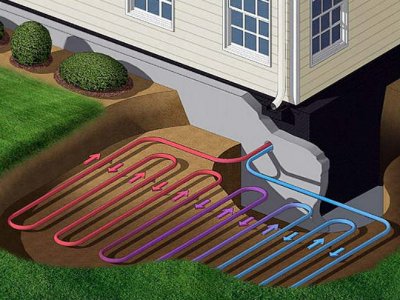
Geothermal heating works like a refrigerator, for heating only. A heat pump is installed on the ground surface, from which a heat exchanger is lowered into the shaft.
Groundwater flows through the device upwards, heating up along the way. The heated liquid is used to heat the premises.
Energy consumption for heating water less than the heat output received.
Operating principle
The collector supplies warm water to the evaporator. The refrigerant, heating up, evaporates. The steam is heated by the compressor due to electricity. The condenser cools the steam, causing release of heat energy and return of the refrigerant to its original liquid state.
Heating water requires electricity. Every kW expended brings, on average, 5 useful kW of energy.
Equipment list
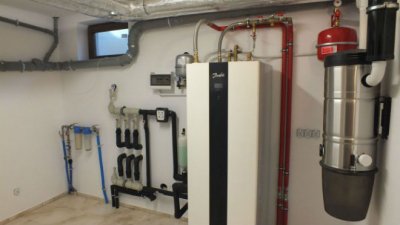
To create geothermal plant 4 devices are required:
- collector;
- evaporator with refrigerant;
- compressor;
- capacitor.
Among the listed components two require an electrical connection: compressor and condenser.
Advantages
Geothermal heating has advantages over other types of heating:
- The energy obtained is applied for any purpose.
- Fuel supply duration to a specific area not limited.
- Its use environmentally friendly.
- Installation does not require frequent maintenance.
- The system pays for itself over time.
- Geothermal plant takes up little space: no bigger than a refrigerator.
- If necessary, the system easily reconfigurable.
- Compatible with other types heating.
Flaws
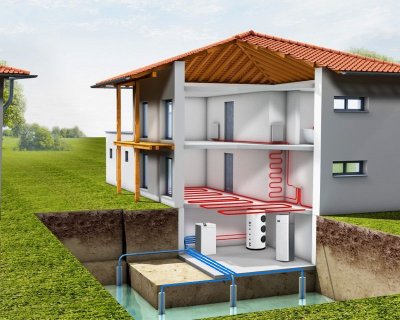
Although geothermal heating has many advantages, it has There are also disadvantages:
- Expensive system and installation.
- Pays for itself in about in 10 years.
- System can't be used in areas with temperatures dropping below 20 degrees.
- Regardless of the type of installation, the following are required: large-scale earthworks using rented devices.
Internal and external views of earth contours
The basis of the system - a heat pump connected to two contours: external and internal.
Inner contour consists of pipes and radiators that transmit the energy of heated water into the room. They can be supplemented by underfloor heating.
Outer contour — a system that supplies heat to the interior. Water circulates along the circuit, supplemented with an antifreeze component. In geothermal heating, the liquid is called a heat carrier. So the heat carrier enters the heat pump, heating up due to the increase in pressure. The heated liquid enters the internal circuit, transferring heat to the room. Then the cooled water goes to the depth, where it warms up. Thus, the cycle is repeated.
Air to water heat pump: diagram
Heat pump is a piece of equipment used for heating. Device collects heat from the air, converting it into energy. With its help, the pump heats the water, which gives off heat to the room. The operating principle of the air-to-water pump is in the reverse Carnot cycle. The devices are capable of functioning as long as the outside temperature exceeds 20-25 degrees below zero.
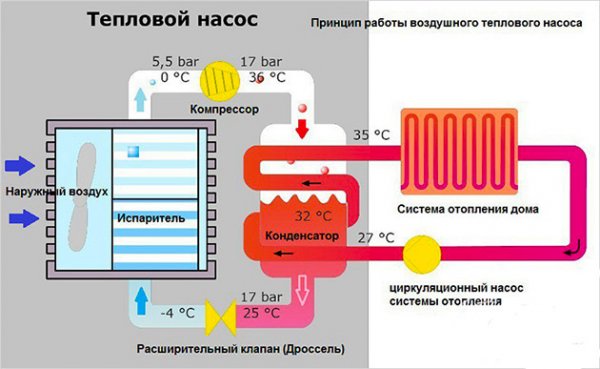
Photo 1. Schematic diagram of the air-to-water heat pump structure. In this case, the heat collected from the air is converted into energy.
System consists of four components. Circulates along the outer contour freon, which is converted into steam in the evaporator. The gas is then compressed in the compressor and passes into the condenser. The steam condenses into water, which is returned to the cycle, and the heat released in the process heats the water in the internal circuit. Thus, two cycles occur: circulation of water with a coolant through the ground; heating of rooms through radiators.
Air-to-water heat pumps depend on the outside temperature. In severe frosts, heating works problematically, since the freon in the external circuit freezes. This is the reason for using systems in warm countries, where the temperature rarely drops below -10. In such areas, geothermal heat allows for more than just heating, but also hot water supply.
If the outside temperature drops to the maximum level of freon operation, the system automatically connects alternative heating using electricity or gasAs the temperature rises and the geothermal plant resumes operation, the alternative source is switched off.
Horizontal installation of a system operating due to the heat of the earth
Horizontal laying of the outer contour is used in areas where where the ground freezes to a certain depth every year. The pipes are placed below this level in a trench that runs parallel to the ground.

Photo 2. Installation of a geothermal heating system using the horizontal principle. A large pit is required for such a design.
Circulating through the heated ground, the water heats up, enters the heat pump, and then heats the liquid in the internal circuit. Having given off heat, the liquid returns to a new circle along the trench.
Trenches are dug in the ground and pipes are laid. Having finished with the external circuit, the specialist installs the pump and then lays inner contour.
Important! It is better to plant vegetables and fruit bushes in the soil where the pipes are located. Trees, if present, should be replanted.
Advantage is in the variability of the system creation. It is suitable for developed land plots where the construction of a house or country cottage has just been completed.
Flaws consist of a large volume of work on laying pipes; in the impossibility of use in cold regions of the planet. Horizontal geothermal heating limits the planting of trees on the site.
Vertical installation
Vertical type is used in places where horizontal is impossible. For installation of drills several wells, in which the outer contour is installed. Wells are drilled from one point, slightly deviating the angle from the vertical, so more heat is obtained.
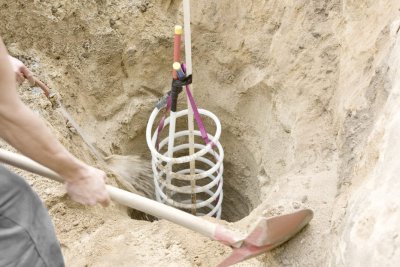
Water is heated as it travels through the depths of the earth, enters the evaporator, and is converted into steam. Airx is compressed by the compressor and suddenly releases energy in the condenser.
The released heat heats the internal circuit, which heats the room, and the liquid is sent to a new circuit through pipes.
In the ground they drill wells and lay pipes. Having created the outer circuit, the builders install the pump, and then lay the inner circuit.
Attention! Drilling requires renting a special rig, which increases construction costs. It is necessary to drill from 50 to 200 meters deep into the ground, depending on the area.
Advantage consists in the possibility of not disturbing the landscape of the developed area.
Flaws: more electricity is required for circulation than for a horizontal system; the use of paired wells for the inlet and outlet of water is not efficient enough.
Installation of geothermal heating for a private country house
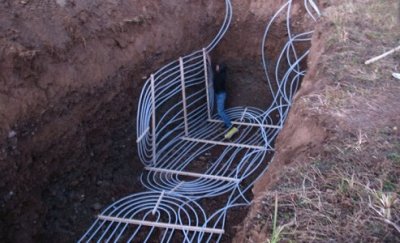
The installation process is as follows:
- preparation, including measuring and selecting components for the work;
- installation of the external circuit of the system;
- installation of the internal circuit;
- setting up work and starting up the heating.
Wells — the outer contour, and circulation pump and batteries - internal. The heat pump is installed in the house.
Outer contour is located in close proximity to the heated building, no further than 10 metersThe connections located in the circuit are crimped.
Useful video
Watch a video demonstrating the installation process of a heat exchanger for a geothermal heating system.
Payback, amount of energy produced
Per kW consumed the system produces electricity 5 kW or more free thermal energy. According to experts, geothermal heating pays for itself in about in 1 decade. This value decreases with increasing area of the heated room.


